The problem with poll predictions in post-pandemic politics
There is plenty of polling around the upcoming state election but very little that seems capable of accurately predicting a result, writes Dennis Atkins


Deb Frecklington and Annastacia Palaszczuk. (Photo: ABC)
In the myriad questions thrown up by the coming Queensland state election, whether the electorate has polarised in this year of the great pandemic sits as both vital and difficult to discern.
There is a dearth of even half-reliable polling to indicate what has been happening or might happen on October 31.
The Currumbin and Bundamba by-elections in late March told us little because One Nation did not contest either seat in 2017 – the Hanson-led party did well in the southern Gold Coast seat and hoovered a large vote in the Ipswich region seat, taking support from Labor.
Beyond these results, we haven’t seen much to point to trends in voting in 2020, although an OmniPoll survey of four seats does suggest some polarisation.
This poll, conducted by the organisation which used to run Newspoll for The Australian prior to 2016, is solid in terms of its sample (500 in each of these seats – Ipswich, Keppel, Mackay and Thuringowa) and its stated methodology.
The polls showed a collapse of the One Nation vote (minus 16 in three seats and minus 22 in Ipswich) and no net gain for Katter’s Australian Party.
This looks like a stretch – has One Nation really lost that much of its support in Ipswich, its historic birthplace, and has Katter’s party remained on a low vote or lost support? Instinct says these are unlikely trends but it is a precedent-smashing year.
If the OmniPoll’s finding that the right of the political spectrum has shrunk or collapsed and the LNP is the biggest beneficiary is correct, there is going to be an interesting contest outside southeast Queensland. It was in the regions that Labor’s vote struggled badly prior to the pandemic and all it has wrought.
The OmniPoll survey was commissioned by the proponents of the New Acland mine in the central west of the state – a development in limbo because of protracted proceedings headed for the High Court and something of a totemic resources project which is apparently cleaving disaffected Labor voters from the Palaszczuk Government.
In fact, according to the OmniPoll results, as many as one in 10 likely Labor voters have turned away from their traditional electoral home because of the refusal of the State Government to back the mine. This much higher than the possible Greens vote in any of the four electorates in the survey.
A remarkable finding in the OmniPoll research is the level of community awareness of the New Acland mine – six in 10 say they are aware of the proposal – and the recorded connection with mining and the resources sector generally.
More than eight in 10 in these four seats say coal jobs “make an important contribution to the economy in Queensland and their region”.
These are results worthy of attention from the Palaszczuk Government, which remains committed to waiting until the High Court outcome, something that’s not due until after the election.
Some in the Labor camp recognise it is an issue but say the overall backing of Annastacia Palaszczuk for her handling of the pandemic makes any intervention unnecessary and a disruption to the core message.
This might have been true a month ago but the current electoral landscape is a moveable feast with lots of interconnected parts. The pandemic and the government’s handling of it remain at the top of most voters’ checklists for reasons to go this way or that.
However, the other dominant issue is jobs and the economy. People know that staying safe is paramount but they are also aware of the need to save existing jobs, get back activity that’s fallen into the COVID-recession and find new ways to generate growth and protect livelihoods.
One weakness in the OmniPoll research of those four seats is that the pandemic and the Government’s response to it is not mentioned in the published six-page report on the survey. This might have tweaked some of the findings away from the robust pro-development outcomes.
For those who want a good fundamental understanding of where we are six weeks out from the major polling day (because of the virus, voting is going to spread out over weeks), a recent blogpost by Tasmanian election watcher Kevin Bonham (see Curiouser And Curiouser: Recent Queensland Poll And Poll-Shaped Objects Roundup) provides the best guide published so far.
Elsewhere (in this piece in The Guardian), Bonham has a handy reminder for poll watchers: “On paper, even pre-pandemic, it would have been surprising for Labor to struggle at this election, as Labor has the advantage of not being in office federally.
“Voters often vote differently at state and federal elections, whether to send messages to Canberra or because they like having different parties in power at different levels.
“Only seven state governments have lost while their party was in opposition federally in the past 50 years, all of them older than Annastacia Palaszczuk’s.”
Of course, precedents are so pre-pandemic.












